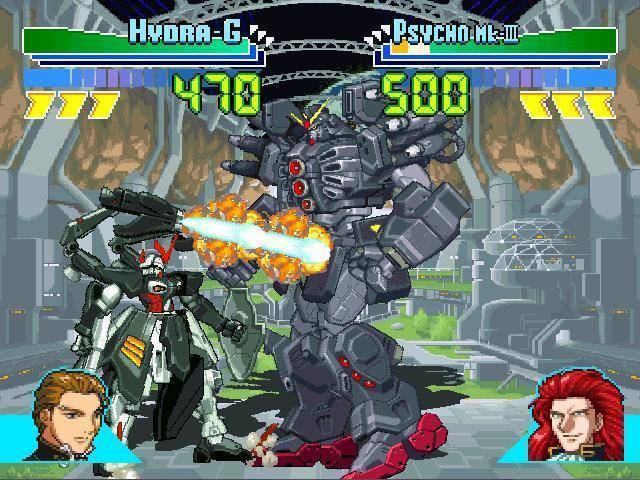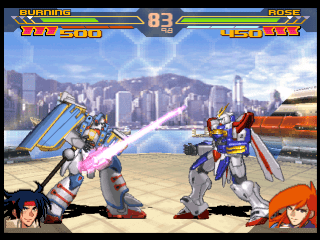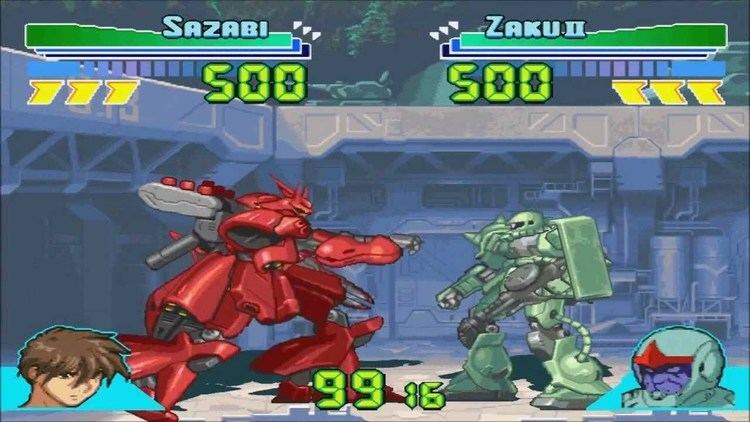Developer(s) Bandai, Natsume Platform(s) PlayStation Genre(s) Versus Fighting | Publisher(s) Bandai Release JP: 1997-06-20 | |
 | ||
Mode(s) Single player, multiplayer Games Battle Assault 3 featuring, Mobile Suit Gundam SEED: Ba, Gundam: The Battle Master 2 | ||
Gundam: The Battle Master, later known as Battle Assault, is a series of fighting games released for the PlayStation, PlayStation 2 and Game Boy Advance. The series features mobile suits from several eras of the Gundam metaverse and some non-traditional fighting game elements. Every entry was developed by Bandai in co-operation with Japanese developer Natsume, who also made the 1996 Shin Kidō Senki Gundam Wing: Endless Duel.
Contents
- Overview
- Gameplay
- Gameplay changes
- Changes to Gundam Battle Assault
- Gundam Battle Assault 2 and The Battle
- Mobile Suit Gundam Seed Battle Assault and Mobile Suit Gundam SEED Destiny
- Battle Assault 3 Featuring Gundam SEED
- Trivia
- References

Overview

Gundam: The Battle Master is the first game in the series, released for the PlayStation in 1997. Even this first game features the large multi-jointed sprites and 2-screen-high stages that the rest of the series would follow on. It includes the following mobile suits from the Universal Century era:
Playable
Bosses (Non-Playable)
Gameplay
Gundam: The Battle Master features gameplay unlike most fighting games, let alone the other games within its series:
Overview
In 1998, Bandai followed up with Gundam: The Battle Master 2, which in 2000 became the first Gundam: Battle Assault release. Though it changed the gameplay system to resemble a more traditional fighting game, seven new mobile suits were added:
Gameplay changes
The game now resembles Endless Duel and the like. All future Battle Assault games were based on this formula:
Changes to Gundam: Battle Assault
The game came out in the US two years later under the title Gundam: Battle Assault. At the time, Mobile Suit Gundam Wing had started on Cartoon Network and was gaining popularity, so Bandai changed the storyline and mobile suit pilots to a Gundam Wing base, among other things. Particularly, the Hamma Hamma mobile suit was removed from the lineup and replaced with the Wing Gundam, though this new character is simply Zeta Gundam (which is still in the game) with a different visual design. Not only that, but this version removed the original intro and credits without replacing them.
In 2001, this version was released in Japan, under the Gundam: Battle Assault title.
Gundam: Battle Assault 2 and The Battle
In 2002, Bandai released a sequel to Battle Assault in North America and Europe titled Gundam: Battle Assault 2. The four Z Gundam mobile suits (Zeta Gundam, The O, Hamma Hamma and Qubeley) and the Wing Gundam were taken out and replaced with fourteen new characters: The main cast of Mobile Fighter G Gundam (including the Devil Gundam as a new end boss), Gundam Wing: Endless Waltz as well as the Gundam Epyon from the Gundam Wing TV show.
Dodging and using beam barriers no longer drains health, it used up the boost gauge instead. The story mode is replaced with a 'Street Mode', in which the player can select from a total of eight mobile suits and very loosely follow the events of the One Year War, the 13th Gundam Fight, and the Endless Waltz OVA.
The original Gundam, a sub-par character in the first Battle Assault, received a major revamp in Battle Assault 2. It now has several new moves and combo options, as well as a devastating super (the Gundam Hammer) which can take an entire life bar off the opponent.
Although the Zeta Gundam, The O, Hamma Hamma and Qubeley were removed from Battle Assault 2, their game code data remains hidden and can be accessed using a cheating device like GameShark.
The game was eventually released in Japan as part of Bandai's Simple Characters 2000 Series (as The Battle) of budget-priced PlayStation games (the series was published by D3 Publisher instead of Bandai themselves), split into two separate games: one focusing on G Gundam and the other on Gundam Wing. One of the differences with the two split versions of the game (other than that Burning Gundam and Dark Gundam's names were restored to their original names, God Gundam and Devil Gundam respectively) was that the Psycho Gundam Mk. III retained its original pilot from the Gundam: The Battle Master games.
Early versions of this game incorrectly spell "Gundam" as "Gundum" on the spine of the case.
Mobile Suit Gundam Seed: Battle Assault and Mobile Suit Gundam SEED Destiny
In 2004, Mobile Suit Gundam Seed: Battle Assault was released for the Game Boy Advance and featured units exclusively form the then-recent localization of Mobile Suit Gundam SEED. The units included all the Gundams from the show sans the Providence, as well as Rau Le Creuset's CGUE and the Gundam Astray Red Frame. It was released exclusively in the US.
The gameplay for this portable installment is similar to its three PlayStation predecessors, with the difference of being faster and more user friendly. The player had the option of choosing a manual method for executing special moves or an automatic one (similar to the easy mode of Capcom's Vs. series). The player could also adjust one of three parameters (HP, Phase Shift Armor or Thrust) at the cost of the other.
There was also an updated version of the game focusing on the SEED Destiny sequel series, named simply Mobile Suit Gundam SEED Destiny. Unlike the original game however, it was released only in Japan and included the original game as an unlockable. This version features all the units from the previous plus the initial suits of the SEED Destiny anime (it lacks Strike Freedom, Infinite Justice, Destiny, Legend and Akatsuki).
Battle Assault 3 Featuring Gundam SEED
Battle Assault 3 is the fifth game in the series. It was released on the PlayStation 2, four months after the GBA installment. It was the first to feature full 3D graphics and it also focused on units from the Gundam Seed anime, including grunt mobile suits like GINNs. However, the Wing Gundam Zero Custom, Tallgeese III, Burning (God) Gundam and Master Gundam appear as unlockable secret characters. It was only released in the US.
